Crud Road Racer Fenders
My long-suffering Francesco Moser roadbike is now sporting some fenders. A 1970s racing bike that originally came with tubulars, the frame has very tight clearances, and the rear brake bridge is particularly low. Even with 23mm tires it will not fit conventional fenders. That is why I wanted to try the Crud Road Racers - described as "mudguards for race bikes with minimum clearances." These fenders are rated to fit bikes with 4mm of clearance under the brake bridge. The Moser has just barely that.
The fenders are modular - the blade in 3 parts, plus the stays - making them easy to store and transport.
To install the fenders, the fork/stay attachment points are first installed using the double rubber bands provided. The fender is then partially assembled, slid under the brake bridge, and then the stays are attached to these points.
This is the attachment point for under the brake bridge. On some bikes it might be necessary to deflate the tire or remove the wheel to do this.
At the point where the fender attaches to the seat tube, there are two sets of holes that the zip-tie can go through, and we managed to tear one of them when adjusting the fender, so be aware. This point of attachment should be the last step, after the fender's position is set.
As part of the installation, Crud provides these fuzzy adhesive pads to guard the tire from rubbing the fender directly.
The rear of the front fender is very close to my toe, but there does not seem to be overlap with my feet strapped in.
The front part of the front blade is a little skimpy compared to the rest of the fenders, but otherwise the coverage they provide is excellent.
The clearance under the rear brake bridge on my Moser is only borderline adequate for these fenders and I am still deciding whether it's a good idea to use them regularly. But I will definitely use them on my new roadbike, where the clearances will be sufficient.
If the fit is right, I think the design is great for road/racing bikes that have tight clearances and no eyelets, or where you simply do not want the commitment of metal fender installation. While I can't speak for the fenders' durability at this stage, I am pleased with their full coverage, easy installation and removal, light weight, and subdued appearance. More pictures here.
Crud is an English company, and according to the packaging information the fenders are manufactured in Yorkshire, UK. Crud has recently become a sponsor, but the fenders pictured are mine and not a complimentary sample. My discovery of the Road Racers is owed to local randonneur Pamela Blalock, who uses them on her main brevet bike and prefers them to other fenders she's tried. Pamela describes the Cruds as highly durable, easy to install and remove, and extremely lightweight - a combination of characteristics that appealed to me. On a pure roadbike with narrow tires, I do not want permanent fenders. But I do want the option of installing them on occasion. While temporary clip-ons exist, they are flimsy and do not provide adequate coverage. The appealing thing about Crud is that they are real, full coverage fenders with the same easy on/off versatility.
Being entirely unfamiliar with Crud fenders to start with, it took us some time to understand how they are put together and what the installation procedure is. There is a brief instructions manual and an online video that might be a good idea to watch before starting. But once you know it's done, I would say the process should take 15 minutes tops.
The installation does not require any tools, and it does not require the hand strength to use real tools. Everything is affixed by hand using moderate pressure, with a combination of the plastic bolts, zip ties and rubber bands included in the kit.
And here is the screw connecting the different parts of the blade.
Zipties are used to affix the fender to the brake bridge.
And also to affix the rear fender to the seat tube, above the front derailleur.
This part of the fender provides extra coverage. The clearances are tight here and it's close, but does not interfere with the derailleur.
Here they are peaking out from the sides.
The rear of the front fender is very close to my toe, but there does not seem to be overlap with my feet strapped in.
The front part of the front blade is a little skimpy compared to the rest of the fenders, but otherwise the coverage they provide is excellent.
Aesthetically, I think the Cruds look elegant and appropriate on a racy roadbike. When fitting bikes like this with fenders, the classic ones don't really look right and the clip-on ones are extremely ugly. To my eye, these look just right. And if you want to make them fancy, they can even be painted.
If the fit is right, I think the design is great for road/racing bikes that have tight clearances and no eyelets, or where you simply do not want the commitment of metal fender installation. While I can't speak for the fenders' durability at this stage, I am pleased with their full coverage, easy installation and removal, light weight, and subdued appearance. More pictures here.

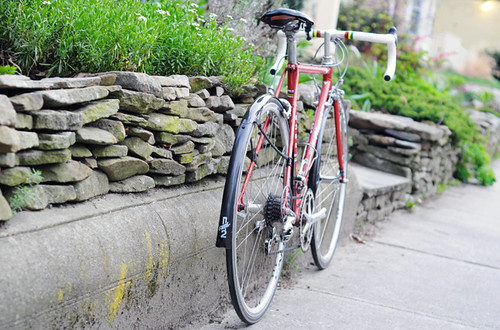
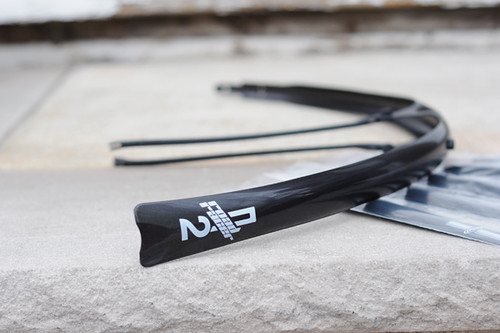
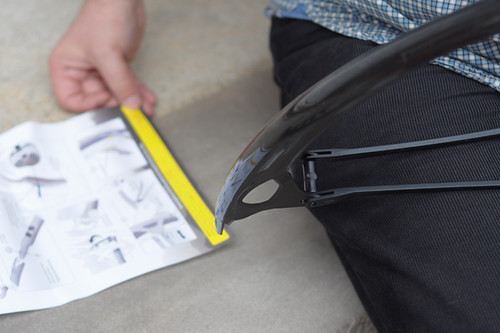

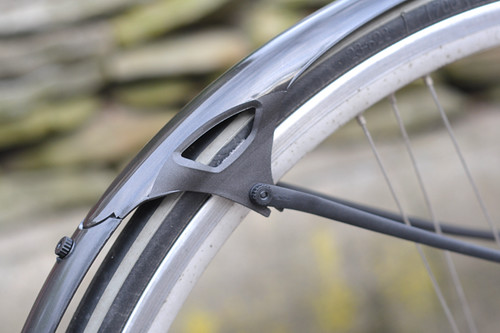
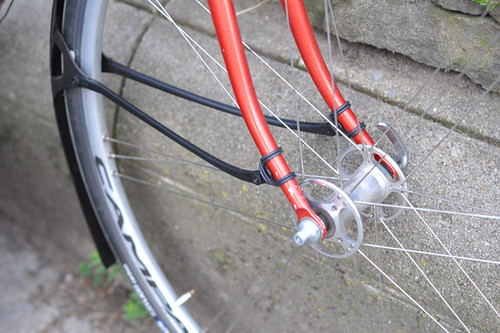
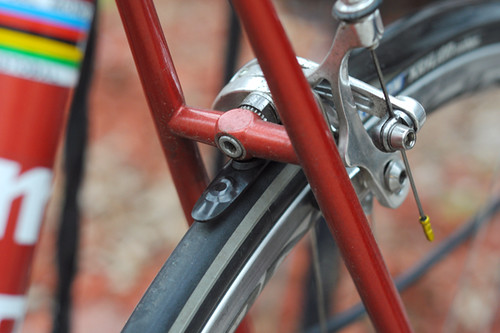
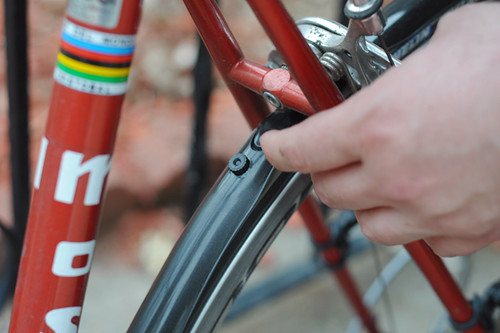


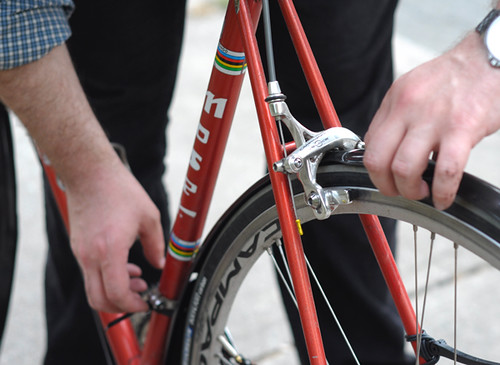



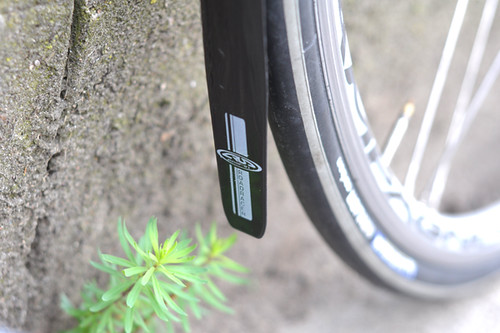

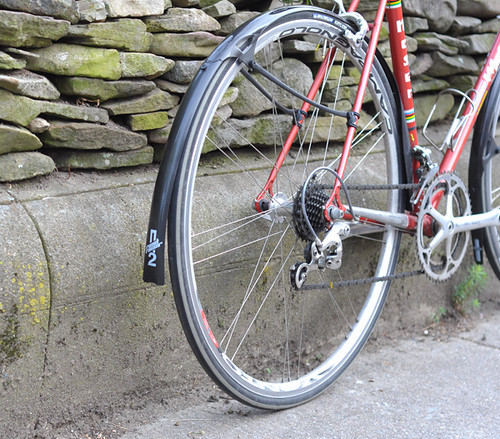

They look okay enough. that they give the brakes a bit of protection is a plus above the 'raceblade' type removable guards.
ReplyDeleteDisagree regarding the looks of conventional fenders though.
I've used Bluemels full guards on both a modern ally & on an old steel framed roadbike. They suited both & worked really well - the ones on the steel bike even more so after repositioning the front guard to keep my feet almost completely dry.
Aesthetically I have mixed feelings about Bluemels. But regardless, they are no longer produced these days (as far as I know?), whereas the Cruds are. I suspect there are many who do not want to stalk ebay auctions for NOS parts.
DeleteOne thing that Pamela Blalock says about these that surprised and intrigued me, is that in her experience the Cruds have been more durable than Honjos and other metal fenders. If true, than that alone seems like a huge plus. I do not think the same is true of Bluemels.
Velouria,
DeleteI don't like the aesthtically, and they appear to be rather poor performers as well. I've used some well make plastic fenders in the past, but metal is the long lasting solution.
Another complaint is they have ruined the look of that nice Moser.
DeleteI disagree. But in any case, they are temporary and removable, so no worries.
DeleteLooking at these as a 'rain day' add on for my steel road bike. Not real crazy about the zip tie approach to securing.
DeleteWondering how the 'rubber band' mounts do in wet weather as I've had the same type mount for my sigma computor 'walk' down the fork.
With zip ties these definitely arn't for CF frames (mho)
NICE fenders!
ReplyDeleteThe Disabled Cyclist
I don't think racing bikes look good with metal fenders either. I always cringe to see pictures of some poor Colnago outfitted against its will with hammered Honjos with the owner proudly describing how he used glue and twine to do it in the absence of eyelets. The Cruds on your F Moser don't so much look good, as unobtrusive. They blend in with the rest of the bike.
ReplyDeleteGlue? That's insane. I prefer to make my own tree sap-based adhesive.
DeleteI've used, and stopped using, Cruds for two reasons. One is that they're designed to rub on your rims (they call it "floating"), which can be somewhat annoying and noisy.
ReplyDeleteThe more serious problem, though, is that the screws that hold them together are quite shallow and have no threadlock on them. This means that by design they work their way loose during normal riding. The instructions actually require users to check the screws before EVERY ride, and it turns out this is necessary - my set lost several screws over a number of months, until I finally didn't have enough left to hold the fenders together anymore. I could have been more vigilant, admittedly (although I did check them periodically), but this seems like a design flaw and one that detracts from the benefits conferred by the product.
Thanks for that feedback. Given that I use the fenders only occasionally, it would take some time before I would spot problems like this.
DeleteFor me, the plastic screws are great, because it means I can install and remove the fenders myself. There is no way I can do that with fenders that require proper tools, because I have very poor hand strength. Personally, I am willing to check the screws in exchange for this convenience, but it is certainly a nuisance for those who are not.
I wonder if there is any way to overcome this problem though - some equivalent of locktite for plastic?
Bubble gum. Or else superglue them permanently and remove the wheels to throw the fenders on.
DeletePeppy, you always have all the answers. Well I hope you're ready to be my bubble gum installation assistant.
DeleteThey are explicitly designed to rub on the rim's brake track with the pile pads, to keep it from contacting the tire. There should be a slight drag on the rim for the first few hundred miles.
DeleteThe fuzzy pile pads are NOT optional as Velouria implied, the fenders will quickly self-destruct without them.
You should also put electrical tape underneath the band-on eyelets: to protect the paint from scuffing, bulk up the interface so the o-rings are tighter, and add some grip to minimize slippage.
cbitterman/ Fred Blasdel - Thanks for pointing this out and I've changed the wording about the fuzzy pads.
Deletei have the crud mudguards and they have not unscrewed as of yet... no rubbing either... i put them on only when it is raining, or before a long ride... no complaints!
DeleteI've used, and stopped using, Cruds for two reasons. One is that they're designed to rub on your rims (they call it "floating"), which can be somewhat annoying and noisy.
DeleteThat's the first thing I thought when I saw that in the description. That right there is a deal-breaker for me. IMHO, a fender should not rub, even if it's just a pad, and even though it's designed to. It's just wrong.
And who says you need to use glue and twine to fit fenders to a racy road bike that only has room for 22 tires and tight clearances??? :)
http://www.flickr.com/photos/7516215@N03/4692955007/
Check out the clearance:
http://www.flickr.com/photos/7516215@N03/4692901365/
Nothing that four p-clamps couldn't solve. Hundreds of miles and nary a rattle or rub:
http://www.flickr.com/photos/7516215@N03/4692895707/
But in fairness, I do like the fact that the cruds are extremely lightweight. That's the one thing I don't like about the SKS fenders on my racy Trek. If the Cruds could solve the problem with rubbing, I'd be all over them.
I too was unimpressed with the design philosophy and the idea of _rubbing_ mudguards when the FixiePixie first got a pair of Cruds. However, I ignored my initial reservations after a Honjo self-destructed on a dirt road in Vermont and just prior to a trip which required packing my (S&S) bike up in its wee case. The Cruds' easy fitting and packability made them an attractive choice at that point.
DeleteNow, 10 months later of hard use later, I see their design philosophy in a different light. The idea of a relatively flexible but _self-centring_ mudguard transpires to be little short of ingenious. They take the knocks that are part of a mudguard's life completely in their stride and they are completely silent in use. I do hear a slight rubbing sound when I wheel the bike backwards but, otherwise, nothing. That is while using them over 30mm wide tyres too, which completely exceeds what they are designed for. Of possible note, I use them with relatively wide rims (23mm), which I suspect adds stability relative to using them with narrower ones.
The wraparound section at the crank/front derailleur is another piece of clever and very effective design. The ability to pop off the lower section of front mudguard is also useful when working on the bike in my favourite workstand, which clamps the front fork, and it is useful too if placing the bike on a typical car-mounted roof rack.
They aren't perfect though. I have lost a nut and bolt after a day of riding in the woods but, on the other hand, I can report that the front mudguard works perfectly well with just one stay! I used some blue (#242) Loctite on the bolts after that and haven't had a problem since.
On the design front, I would appreciate if the lower part of the front mudguard was wider and wrapped around the tyre more. However, FixiePixie's idea of adding some super de luxe packing tape to create a lightweight mudflap works like a charm.
Plastic screws can be made to stay "screwed" better by slightly de-forming (or "upsetting" as the British would say) the threads. A gentle squeeze with a plier or some other pinchy-squeezy sort of thing on the end of the plastic screw might just add enough grip without making it too difficult to remove by hand. I'd leave the first few threads un-funkified to make it easy to start.
DeleteI like the Cruds that I've seen and think that the idea of the rubbing-fuzzy is the genius that makes this approach to racy fenders possible. If there was another method that worked and achieved the same degree of practicality without them then I think we would all be riding around with such things on our bikes already and Crud would never have sold the second pair.
I think they're like Speedo's for bikes and can only imagine how delighted a middle aged retired racer like Francesco must have been when you slipped them on him. Kind of natural casual wear for a 70s Latin Racer dont'cha think? A little cliched perhaps, but hey, who am I to judge.
Spindizzy
Good to know that the Loctite does not degrade the plastic; that's what I'll use then.
DeleteWouldn't want to upset the screws. Or degrade them.
That's probably the wisest choice. It would be a bummer to find you had upset or degraded them when you thought you were being clever.
DeleteSpindizzy
Thanks for reviewing these! I'd no idea that fenders other than those totally inadequate clip-ons were available for race bikes.
ReplyDeleteWhat did I miss? New roadbike? Tell us more!
ReplyDeletemy prediction:
Deletehttp://www.sevencycles.com/road/axiom-s.php
I am considering a little experiment of not naming the manufacturers of the bikes I buy from now on...
DeleteAs V has now corrected and others pointed out the little pads are an important part of the design, as they keep the fender centered over the wheel and keep the fender from rubbing the tire. I would NOT use the phrase *rubbing the rim* to describe the contact these pads make with the rim. I can't imagine there is any measurable friction, but then I use a dyno-hub and carry around a giant seatbag, so what do I care :-) I have now managed to break one of the end pieces and I had one the rear extender piece fall off after a roof rack journey. Fortunately I noticed right away, but couldn't find the bolt in the road, so the end piece came home in my back pocket on that day. I started carrying spare nuts and bolts after that, and check the bolts after any roofrack journey - a pretty rare thing. I've not had any issue with the nuts coming loose, but that is a sample of one. They are not indestructible, but have certainly held up better to abuse than the aluminum fenders we've used. They've also been amazingly effective at keeping me dry *this* year, since it just doesn't seem to rain here anymore :-( Maybe the farmers would like me to remove them - and cause some rain.
ReplyDeleteI really really wanted these to work. But after hours trying to fix them, they didn't. I struggle with the concept of someone who says she can't fix a flat but who can attach these. I am more than averagely incompetent, so don't be put off by me, but don't get the idea these are easy to fix. I didn't even want them to be detachable - I am happy to have them on all the time.
ReplyDeleteThey may be better than when I bought some (winter 2010/2011), and as a fan of mudguards and yorkshire, I hope they are, but I have my doubts..
I am not incompetent; I have problems with my hands. I can fix a flat, but lack the hand strength to get the tire on/off the rim without the whole thing taking an hour of time and all my energy.
DeleteThat said, people (like Fixie Pixie) do have them mounted permanently.
If you remember, leave a comment here a few months down the road re how they work out for you in the long run.
I wouldn't call it permanent. I have taken them off a few times. They were off quite a bit last summer! I keep expecting this spring to return to normal and get wet, and I'm so superstitious that I believe I will cause biblical flooding in New England if I remove them too soon!
DeleteI have both sympathy and empathy on the hand strength point. Why do so many repair manuals show people pushing tyres back on with their thumbs (just about impossible) rather than heels of the hand (just about possible)? It's not as if cycling is full of musclemen. Rant over.
DeleteNo long term test possible - after a few evenings trying to get the £&@*** to clear the tyres I chucked them in the interests of my blood pressure.
"If at first you don't succeed, try again. Then quit. No point being a damn fool about it."
It's great you've found fenders that will fit the minimal clearance. Just as a personal view, I'm not in love with the look of the 'placky' stays, but, function over form, eh?
ReplyDeleteI am not in love with the look either, but I find it much less of an eyesore than any of the p-clamp and "filth prophylactic" style fenders out there. As someone else noted, the fenders basically disappear into the bike; I do not see them or think about them. Aside from the slight rubbing that is : )
DeleteGreat review. These look better than the raceblades and other similar fenders for race-clearance frames. I, too, wonder/worry about the centering pads that "rub", but...
ReplyDeleteLike many fans of this blog, I love me some fenders. Until this past weekend, I had a set on every bike but my mtb. (Even the mtb had some, BITD when it had drop bars and a rear rack and other signs of tourish aspirations.) I converted my old fuji roadbike (which had fender clearance issues in the rear with even 23s) to 590s just to put real fenders on the frame. But,I'm finally coming around to the notion that not every bike needs fenders; in fact, there are bikes which SHOULD NOT have fenders.
These, however, are a good option for the cyclist who needs a racing road bike and cannot house more than one or two bikes... The rest of us, I reckon, should simply ride one of our more sensible bikes when it rains.
"But,I'm finally coming around to the notion that not every bike needs fenders; in fact, there are bikes which SHOULD NOT have fenders. "
DeleteI experienced this realisation last summer, when I found that (1) riding a fenderless roadbike felt somehow more free, less fussy, and (2) I really do not care if my butt is splattered with mud when I am wearing cycling shorts which will be washed after the <50 mile ride anyway. YMMV!
my carbon fiber "road" bikes have p35 sks fenders installed year round. since i ride in the city (alot) it is only courteous to fellow riders to use fenders. one of the more irritating aspects of urban riding is eating road slime because the prototypical ironic fixie or foppish roadie is too "cool" to use fenders. if you are racing, by all means go fenderless, but if you are commuting or training and there is even a tiny chance of rain, install some @#!@#$@ fenders!
DeleteIn the city I ride a bike with fenders. And a chaincase. And upright handlebars. I don't ride my roadbike in the city other than the 2 mile stretch I have to go through to get out of it.
DeleteThis slime in the face thing... You know, most of the people I ride with do not have fenders on their roadbikes and I have yet to experience being sprayed in the face from their tires. And I mean, I've done pacelines in the rain, so how much worse can it get?
Don't get me wrong, I like fenders. They serve a purpose. But on a roadbike that is used exclusively for sport and not for transportation, their utility is not always worth the hassle, in my experience.
Without doubting the veracity of our hostess for a moment regarding her clean face oh yes it can get much worse.
DeleteThere will be variation with different tire treads. There will be variation from different types of paving. There is variation in how much and what sort of slime has been living on the pavement. Speed makes a big difference too but 15mph is usually enough to throw a rooster tail as high as a face. If the rain is warm and the pavement is clean none of this matters. Usually it's not that nice.
Looks like I need more experience in this regard : ) It's a good thing I usually wear my sunglasses, even in bad weather.
DeleteBought these for use in randonneuring. Very beneficial on a 600k with heavy rain. But the screws came loose (despite the tiny plastic nubs to prevent just that). The end of the rear fender fell off and was lost. The end of the front fender cracked and fell off. But what about safety concerns (debris...locked front wheel...flying over the bars)? Would CRUDs break apart like the safety releases on SKS, Planet Bike Cascadia and Blackburn Cloudburst?
ReplyDeleteWithout singling out specific brands, I have read and heard horror stories about other fenders breaking and causing crashes, despite supposed safety releases.
DeleteAs part of the design of the stays is a QR/safety release when catching a twig. The fender will pull free of the stays - the stays are open ended. I have put this to the test once - it worked as intended. They fender released but did not break.
DeleteI have used these fenders for 2 years and have found them to be wonderful on my roadbike. I live in the Pacific Northwest so rain is quite common.
ReplyDeleteThe fenders can be easy adjusted to not rub. Simply slightly loosen the screws holding the fenders and the screws holding the stays, pull up on the fender a bit, hold and then tighten the screws. This will allow them to resettle into a position that is centered and a bit higher.
If you are only concerned about side-to-side rubbing, do the same with only the top two screws or slightly twist move the plastic base so that the stays move slightly to the side, which in turn will move the fender.
Doing the above, my fenders do not touch my wheels, do not rub and even the brushed do not touch my rim (except when actually riding).
I have also lost a screw and tail flap - I used one of the replacement ones that it came with and used 2 smalll ziplocks to attach.
After reading this post I ordered a set of these for my old Peugeot roadbike turned commuter. I've been looking for fenders that would fit that bike, to protect the brakes a bit from getting perpetually gunked up.
ReplyDeleteFirst impressions: they were pretty easy to attach. And I don't have very nimble or strong hands. (Coming up on 40 and can already feel the family curse of arthritis in my hands.) Missing two zip ties from the box, which was irritating. I was surprised to see that the instructions call for trimming one of the pieces with a hacksaw! I don't think I need to — the part *just* fit — but that was a little unexpected. I don't own a hacksaw.
I second what was said above about putting electrical tape around the bike where the fender stays attach — something I learned the hard way when the rubber-coated P-clamps from my rear rack rubbed patches of paint away down to bare steel on my seat stays!
Now to see how the fenders do at keeping the bike (and me) a little cleaner the next time the weather turns foul!
I'm a little late to the game (have been touring) but here's my take on the Cruds: I bought them maybe 2 years ago but have rarely bothered putting them on my Gunnar Roadie. First, I found the installation to be pretty cumbersome and taking a lot of time. I might get down to the 15 minutes you mentioned with more practice, but frankly even 15 minutes is too long for my liking. If I have the choice of fiddling with the fenders for 15 minutes or just hopping on my fully-fendered Cross-Check I tend to go for the latter. Part of the installation issue that the rubber O-rings don't work well for my aero-ish crabon fork -- it's just too wide. Then there is the issue that Crud strongly advises against using them with tires wider than 23mm. I haven't actually tried it with my 25mms yet (I vaguely remember FixiePixie successfully using them on 25mm tires) but I suspect that the rubbing that I already found annoying when using 23mm tires will only get worse. Well, maybe this post will give me inspiration to give them a second chance.
ReplyDeleteHi,
ReplyDeleteIt's very late to come to this topic, but as a non-destructive and non-sticky possible solution to the bolts unscrewing is to use some plumbers PTFE tape to wrap over the threads. This is very thin but as long as it does not create too much pressure and damage the threads, it may just add that extra grip to keep the bolt in place.
There is a new mudguard coming soon called Quickguard which requires no zip tie, rubber rings or even stays touching the frame, and unlike the Cruds and other conventional mudguards it can be installed and removed in just a few seconds. Check out the website for its development at www.bicyclequickguard.com
ReplyDelete